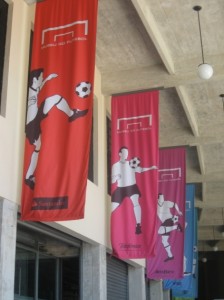
Photo © Michael Sommers.
Ever since I heard friends – female friends, female friends who hate soccer – rave about Brazil’s spanking new Museu de Futebol, I’ve been dying to visit the place. The Museu de Futebol is located in São Paulo’s Estádio do Pacaembu, a fabulous Art Deco stadium that was completed in 1940 and inaugurated with much pomp and circumstance as the largest soccer stadium in Latin America.Games featuring São Paulo teams are still played here (for this reason, it’s always a good idea to check out the visiting hours on the museum’s web site). In fact, the long line-up snaking its way out into the parking lot on a Sunday morning – which I initially feared was proof of the museum’s great popularity – turned out to be full of local fans waiting to buy tickets for a game later in the day.
Aside from a permanent collection, the museum hosts a series of temporary exhibitions. On until March 14, “Ora, Bola! Futebol Pelo Mundo” features over 50 massive photos of people playing soccer throughout the world’s five continents along with Antarctica (where the use of a red ball is a necessary adaptation). It comes as a moving surprise to learn that FIFA recognizes more countries than the United Nations (one of which is Palestine; a pick-up game amidst the ruins is depicted) and that on Chile’s Diego Garcia island, local kids can only get their balls inflated once a month when a visiting ship arrives with a pump. The exhibit really does make the case for soccer as the great unifier that transcends politics, geography, religion, and economic circumstances.
Kids in particular will love the final room where they can play a simulated game of soccer projected on the floor or test the potency of their goal kicking abilities by firing a real ball against a virtual goalie. The rest of the museum makes a similar case for the role of soccer in Brazil. The permanent exhibition kicks off by stoking everyone’s inner soccer fan with two interactive caverns. The first pays homage to Brazil’s 25 greatest soccer gods of all time (nicknamed the Baroque Angels). The second features dozens of panels that allow you to select footage of the greatest goals of all time and listen to radio broadcasts dating back to the ’30s in which commentators scream “GOOOOOOOOLLLLLLL!!!!” in that amped-up, ecstatic way characteristic of Brazilians.(Aside: I was surprised to discover that one of the great soccer commentators of the early ’40s was none other than the great composer Ary Barroso, author of the famous “Aquarela do Brasil“, or simply “Brazil” as it is known in English. To hear this anthemic song in its entirety, check out this excerpt from the wonderful 1942 animated short, Saludos Amigos, which uses the song as its soundtrack and inspiration.)
If you’re not emotionally engaged by the time you’ve made it through these displays, you will be when you arrive at the “Exaltation” display where enormous projected videos of fans representing 30 Brazilian teams hiss, boo, scream, cheer, sob and samba from bleachers that are projected directly onto the undersides of Pacaembu’s bleachers. The sensation is so similar to being right in the middle of a championship game that you can practically smell the excitement (you actually can smell that damp concrete bleacher smell).
The flip side of this display is the equally moving “Rite of Passage” room in which a wall-sized video pays homage to the biggest disappointment in the history of Brazilian soccer. This cataclysmic moment occurred during the 1950 World Cup. Since the Cup was hosted by Brazil – with major games played at Rio’s spectacular new Maracanã stadium – Brazilians were certain they’d emerge as champs. The images of the players and supporters at the humiliating game in which Uruguay came from behind in the game’s final minutes and beat the home team by 2-to-1 are heartbreaking After the defeat, the 200,000 fans – a 10th of Rio’s population at the time – remained in stunned silence for half an hour before leaving the stadium. Subsequently, the Brazilian selection abandoned its all-white uniforms, which were considered to have brought the team bad luck.
Other rooms trace the history of soccer in Brazil from its introduction in the late 1800s to the present day while making insightful parallels to what was going on in Brazilian politics and culture at the time. Even if you don’t read Portuguese (an English audio guide is available) and have little knowledge about Brazil, the iconography manages to be captivating (especially since it’s punctuated by plenty of footage of actual goals being scored).
Kids in particular will love the final room where they can play a simulated game of soccer projected on the floor or test the potency of their goal kicking abilities by firing a real ball against a virtual goalie. Meanwhile, the next best thing to Avatar for the soccer set is a 3-D short in which you get to watch current craque Ronaldinho Gaúcho samba-dribble a ball in the company of a (his?) skeleton.
If after all this, you haven’t been converted to the cause, spend a couple of minutes gazing at the green and yellow jersey displayed as if it were a holy relic. Yes, just as the Louvre has the Mona Lisa, the Museu de Futebol has Pelé’s retired No. 10 jersey worn at the historic 1970 World Cup Game in which Brazil beat Italy to win their third World Cup in what many Brazilians claim was the most beautiful of the “beautiful game”s ever played.